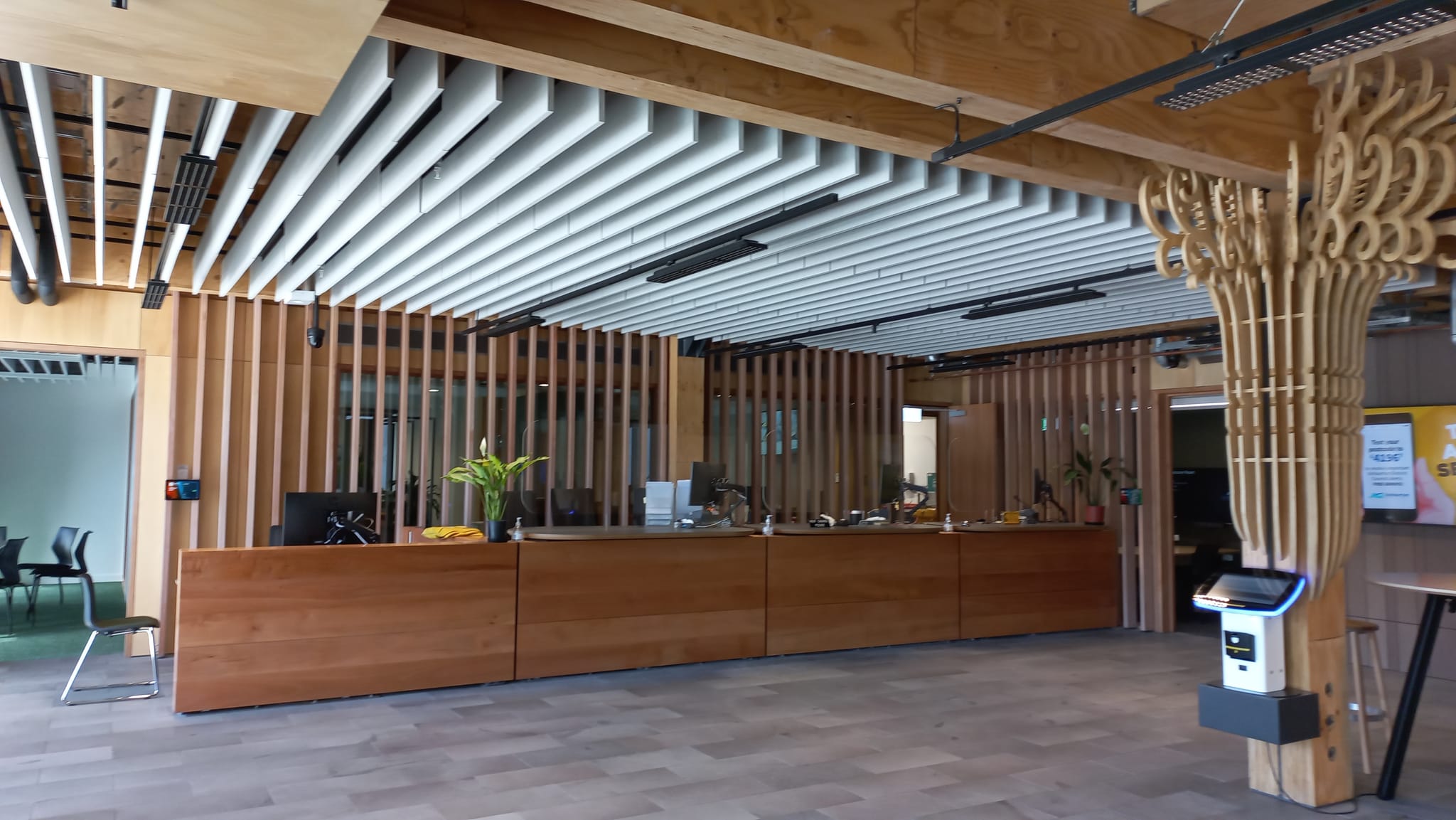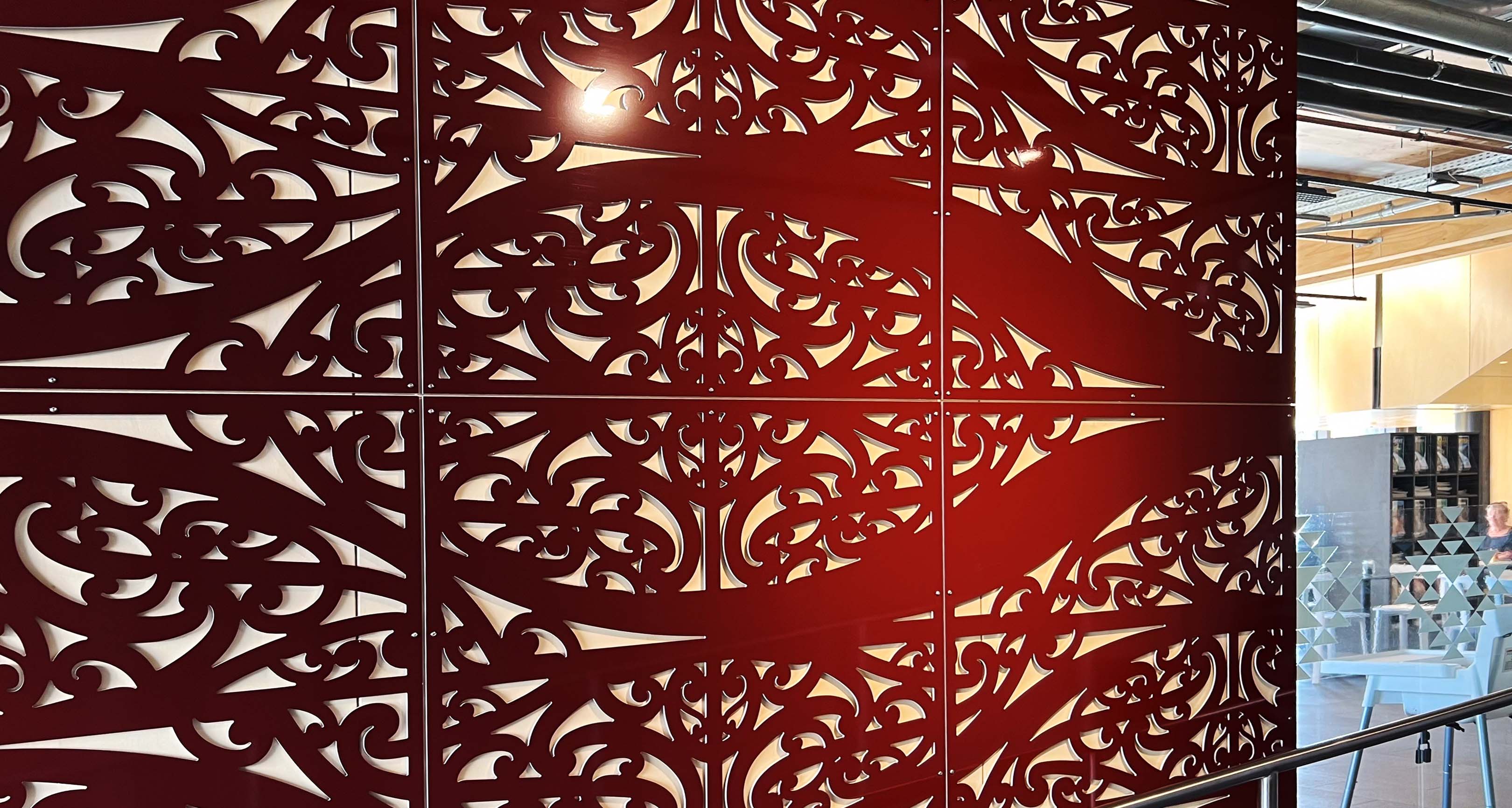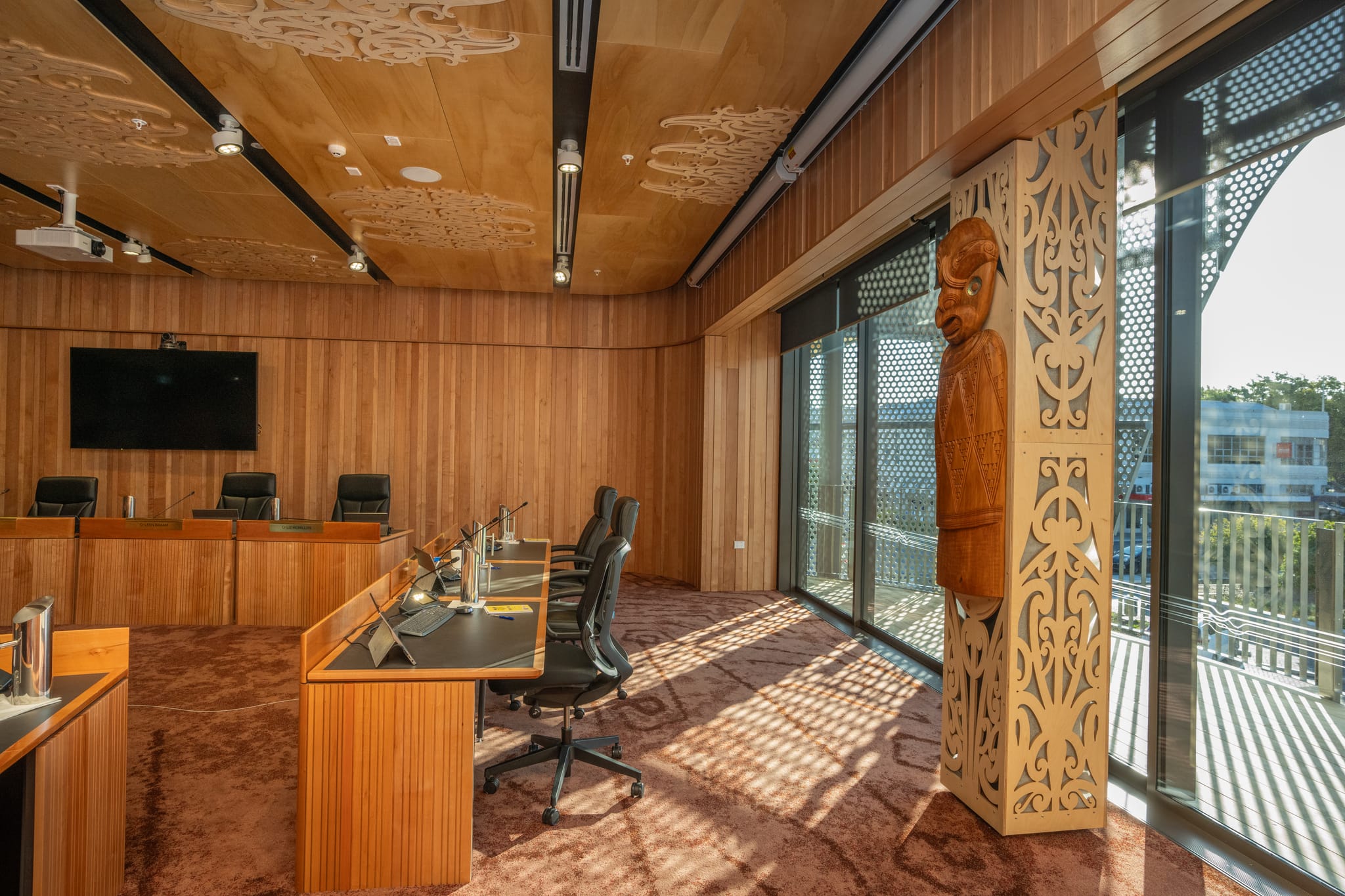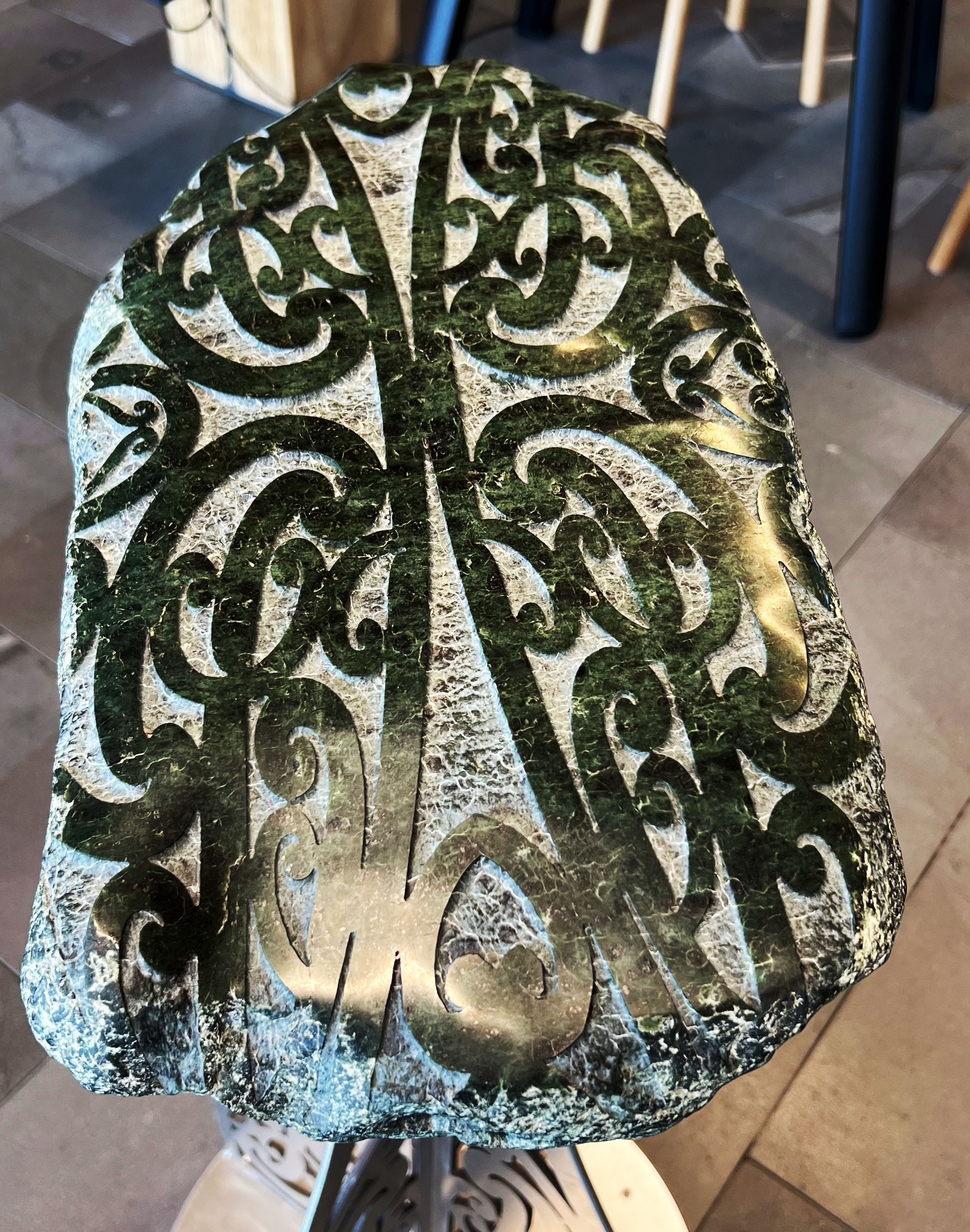Te Whare Whakatere Cultural Narrative
Main Composition
The cultural art package that adorns Te Whare Whakatere – The Ashburton Library and Civic Centre building is the work of master carver and renowned artist Fayne Robinson (Kāi Tahu, Ngāti Apa ki te Rā Tō, Ngāti Porou). Fayne’s work can be found throughout the Centre, with the various design elements both inside and outside working seamlessly to draw together the overarching concepts of Te Taiao (the environment), Tākata (people) and Tūhonoka (connection)
Many of the Hakatere / Ashburton district’s unique natural features; the braided river systems, the plains, wetlands, native flora and fauna are reflected in intricate Māori designs seen in both the traditional and contemporary mediums utilised. The focus on the region’s environmental markers speaks to the area’s long and uninterrupted occupation and the inherent ability of the whenua to sustain and nurture the people living upon it.
Woven throughout the artworks are themes of travel and transition; the flow of the braided rivers from the mountains to the sea, the network of traditional Māori trails and pathways that traversed the whenua, as well as themes of settlement, growth and potential as depicted through ancient rock art, pūrākau (Māori narratives) and representations of young tī kōuka trees.
This art package celebrates the connection between tākata (people) and whenua (land), acknowledging the land’s ability to sustain us and emphasising the undeniable responsibilities and obligations to the whenua of those who live in the area today.
Patterns and motifs
Several distinct patterns and motifs are interwoven through the art package.
Traditional kōwhaiwhai patterning, representative of the region’s braided rivers, flows from Baring Square East, through the foyer and public areas and sweeps upwards into the heart of the building. The patterning includes puhoro; an artistic representation of the river’s channels and currents and a reflection of the many diverse pathways that bring people to and from the space; mangopare: a design that harnesses the strength mindset of the Hammerhead shark and reflects the unity of purpose within the work undertaken in the building, and koru: the familiar and easily recognisable frond design that symbolises strength, growth and potential. Elements of the district’s unique geography, flora and fauna find form in the negative space of the kōwhaiwhai patterns and in the geometrical tāniko designs seen on the windows of the main entranceway and of Te Kete Tuhinga.
A central depiction of Hinepaaka, both a prominent historical landmark and the renowned Kāi Tahu ancestress from which it was named, and depictions of ancient rock art gives prominence to local Māori history, and mātauraka and uara Māori (Māori knowledge and value systems). While Hinepaaka’s ceremonial and geographic significance to early travellers entering the district gives support to the idea of the area’s diverse modern cultures moving forward together.
Lastly, but no less importantly, some traditional design elements have been deconstructed and subsequently refashioned to portray the specific movement of the water in our braided streams and rivers. These restyled designs, at once soothing and calming, yet still powerful and consistent, are reflective of the notions of transition of people across the landscape and of transmission of knowledge across the generations.
Ratonga Kaunihera | Customer services and entrance
Manuhiri (visitors) approaching from Baring Square East are welcomed by sets of footprints and traditional puhoro patterns infused with kōwhaiwhai designs etched into the ground outside Te Whare Whakatere. The footprints come and go in different directions, representative of the many pathways travelled by the region’s residents and of the many diverse reasons for people’s engagement with the Council and its services. The puhoro patterns capture the essence of our unique braided river systems that, in traditional times, enabled travel to and from the interior. The footsteps and braided river patterning are sandblasted 1-2mm into the ground providing a practical safety aspect to the approach.
 These puhoro patterns are reflected in the two pou (posts) flanking the entrance way and then echoed inside the building. The permanent pathways outside make way for more contemporary expressions of connection and of guidance on windows and glass panelling on all levels of Te Whare Whakatere.
These puhoro patterns are reflected in the two pou (posts) flanking the entrance way and then echoed inside the building. The permanent pathways outside make way for more contemporary expressions of connection and of guidance on windows and glass panelling on all levels of Te Whare Whakatere.
Before entering the building, manuhiri are greeted with taniko patterning across the doorway that features the diamond shaped pātiki (flounder) design. This design speaks to the important mana whenua ideal of manaakitaka (caring and hospitality) expressed through harvesting and sharing kai gathered from the whenua. In this context the pātiki design represents hospitality and providing for the people of the Ashburton/Hakatere region. In the right light, the design projects through to the foyer and customer services space.
On arrival into the foyer and customer services area there are several design elements waiting to catch the eye. Wooden depictions of juvenile tī kōuka trees symbolise beginnings, growth and potential, and link to the main Hinepaaka motif. The kōwhaiwhai design spreads outwards and upwards, appearing on interior balustrades and window panels. Many of these designs include images of taoka species and of traditional food sources, reinforcing again the idea of manaakitaka and of providing for manuhiri. This design is also reflected in the pounamu touchstone that sits near the customer serve area.
Te Kete Tuhinga | Library staircase

The staircase that links the two floors of Te Kete Tuhinga, features an ancient rock art design known as the ‘Ōpihi Taniwha’. Kā Tuhituhi o Neherā (rock art) is of major significance to the local mana whenua, Kāti Huirapa, who have direct whakapapa (genealogical) links to the historical peoples credited with this ancient art form. This rendition, made from stainless steel, is a representation of a plaster cast version that stood in the previous Council Chambers, and is a tacit acknowledgement of the connection between the two buildings.
Plaque - Kā tuhituhi o neherā | Māori rock art
The distinctive ‘Kā tuhituhi o neherā’ (Māori rock art) appears in caves and rocky outcrops throughout South Canterbury. Serving as both shelter and canvas for generations of Māori travelling the complex networks of trails that traversed Te Waipounamu, the caves and rocky outcrops provide us with a fascinating glimpse into the lives of these early travellers. This particular design piece is based on a rock art drawing known as the ‘Ōpihi Taniwhā’ and is an image that holds special significance to the local people of Kāti Huirapa, who have direct whakapapa (genealogical) links to the historical peoples credited with this ancient art form. A plaster cast rendering of the Ōpihi Taniwha featured in the previous Council Chamber and its inclusion in Te Whare Whakatere acknowledges the link between the old and the new buildings.
Ka kitea te toi motuhake 'Kā tuhituhi o neherā' i kā ana me kā tāmore toka huri noa i Waitaha ki te toka. Kua noho kā ana me kā tāmore toka hai maru, hai taitapa toi anō ki kā reaka Māori e whai ana i kā ara tawhito e whakawhitiwhiti ana i Te Waipounamu. He kapohaka whakamīharo o te ao o aua kaipōkai whenua tōmua. I takea mai tēnei nei nā toi hoahoa i te tuhituhi o neherā ka kīia ko te 'Ōpihi Taniwha'. He ata nui whakaharahara tēnei ki te hapū o Kāti Huirapa, he kāwai whakapapa nō rātau ki kā tīpuna nā rātau tēnei toi o neherā. I te Taiwhaka Kaunihera o mua tērā tētahi toi ukutea o te taniwha o Ōpihi, nā, ka uru anō ia ki Te Whare Whakatere hai mihi ki te honoka o te whare o mua ki tō nāianei.
Te Kete Tuhinga | Library entrance
 The design panel situated in the side entrance to the building close to Te Kete Tuhinga, the Ashburton Library, echoes the themes of travel and transition. Traditional design elements have been reformed to create a representation of the ebb and flow of the water in our braided rivers and to give a sense of both the river and the land moving together. The ripple effect within is calming and soothing yet hints at the power and consistency of the currents. Historically, our rivers provided passageways to and from the interior and beyond, enabling the flow of people, of trade goods, of harvested kai and of knowledge. The idea of knowledge transmission is central to the design’s placement in the vicinity of the library.
The design panel situated in the side entrance to the building close to Te Kete Tuhinga, the Ashburton Library, echoes the themes of travel and transition. Traditional design elements have been reformed to create a representation of the ebb and flow of the water in our braided rivers and to give a sense of both the river and the land moving together. The ripple effect within is calming and soothing yet hints at the power and consistency of the currents. Historically, our rivers provided passageways to and from the interior and beyond, enabling the flow of people, of trade goods, of harvested kai and of knowledge. The idea of knowledge transmission is central to the design’s placement in the vicinity of the library.
Hine Paaka | Council Chamber
A central motif rising up through the heart of the building is that of Hinepaaka. The name Hinepaaka references a preeminent female Kāi Tahu tipuna (ancestor) of noble lineage and a single ancient Mataī tree that stood near the Alford Forest, inland from Ashburton. The Mataī tree, imbued with the mana of the illustrious ancestress, served as an important route marker, and a significant ceremonial site for travellers entering the lands of the local Kāti Huirapa people.

This patterning is seen on the main pou (post), climbing from the ground floor to the Council Chambers, much like the sturdy trunk of the tree, where it then branches out across the ceiling in a pattern reminiscent of the trees spreading leaves. The design lights up at night to represent the mauri (life essence) of the Mataī tree.
Standing outside the Hinepaaka Council Chamber is a remnant piece of Mataī salvaged from the Ashburton floods in 2021. Design elements of the motif have been carved into the wood.
The positioning of this pūrākau (traditional narrative) in the heart of the building and into the Council Chambers is significant and it acknowledges the importance of the decision-making that takes place in the space and the impact those decisions have on the lives of those living in the area. The significance and mana of the tipuna Hinepaaka is also acknowledged in the carved pou that stands overlooking the chamber.
Plaque - Pōhatu pounamu | Pounamu touchstone
 Pounamu (nephrite jade) is a taoka – a highly prized treasure and an intensely valued resource for mana whenua. This pounamu was sourced from the Arawhata River in South Westland and is representative of the connection provided by the ara tawhito (ancient trails) that spread across Te Waipounamu and historically linked local Māori from the Hakatere region to the pounamu resource of the Te Tai Poutini. The pattern etched into this stone echoes the welcoming motifs seen as you enter this whare and represents the mauri or essence of manaakitaka (generosity, hospitality and support) extended to all manuhiri (guests) who arrive here today. Manuhiri are invited to gently rub this touchstone to engage with the positive mauri within.
Pounamu (nephrite jade) is a taoka – a highly prized treasure and an intensely valued resource for mana whenua. This pounamu was sourced from the Arawhata River in South Westland and is representative of the connection provided by the ara tawhito (ancient trails) that spread across Te Waipounamu and historically linked local Māori from the Hakatere region to the pounamu resource of the Te Tai Poutini. The pattern etched into this stone echoes the welcoming motifs seen as you enter this whare and represents the mauri or essence of manaakitaka (generosity, hospitality and support) extended to all manuhiri (guests) who arrive here today. Manuhiri are invited to gently rub this touchstone to engage with the positive mauri within.
He taoka te pounamu - he taoka puipuiaki, he rauemi tino whai take ki te mana whenua. I takea mai tēnei pounamu i te awa o Arawhata i te takiwā o Makaawhio. He tohu o te honoka nō kā ara tawhito huri noa i Te Waipounamu o kā takata Māori i te rohe o Hakatere me tēnei mea te pounamu i Te Tai Poutini. I te tauira kua tākia ki tēnei pōhatu, ka kitea anō te āhua o kā tohu pōwhiri i te kuhuka ki tēnei whare, he tohu anō o te mauri o te manaakitaka ka tau ki kā manuhiri katoa kua tae mai i te rā nei. Ka akiakina te manuhiri ki te āta mirimiri i tēnei pōhatu kia pākia ko te mauri o roto.
